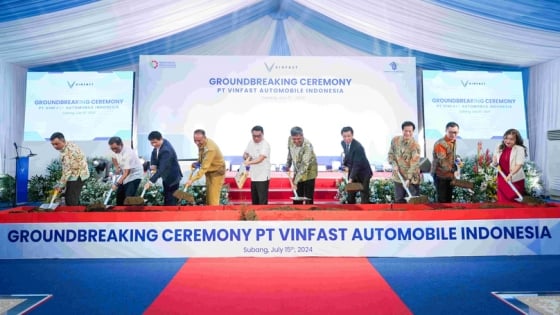by
Triduc
Monday, July 15, 2024, 5:10 PM (GMT+7)
VinFast, a unit of Vietnam’s largest privately held conglomerate Vingroup, on Monday began construction of a $200 million factory in Subang, West Java, Indonesia.
This strategic move into one of Southeast Asia’s most promising EV markets underscores VinFast’s commitment to expanding its presence in the region and supporting Indonesia’s burgeoning electric vehicle industry, the company said.
VinFast’s new EV assembly plant has several major production areas, including a body shop, general assembly shop, paint shop and testing area, with an annual production capacity of 50,000 units.
VinFast held a groundbreaking ceremony for its factory in Subang, Indonesia on July 15, 2024. Photo courtesy of VinFast.
The factory is scheduled to start operations in the fourth quarter of 2025 and will supply right-hand drive versions of VinFast’s e-SUV models for the Indonesian market, including the VF 3, VF 5, VF 6 and VF 7.
The Indonesian government is encouraging foreign investment in the automotive sector, said H. Moeldoko, head of the Indonesian President’s Office. “We believe that VinFast’s presence will bring much-needed technological innovation and knowledge transfer to enhance the competitiveness of the domestic automotive industry,” he added.
VinFast has begun operations at its current manufacturing facility in Hai Phong, a coastal city in northern Vietnam. The company broke ground on its EV and battery production facility in North Carolina, US, in July 2023. Total investment will be around $4 billion, half of which will be in the first phase.
In February 2024, VinFast officially began construction of its first integrated EV manufacturing facility in the Indian state of Tamil Nadu. According to VinFast, the EV facility will boast an initial investment of $500 million over five years out of a total investment of $2 billion, with an expected production capacity of 150,000 units per year.
EV maker VinFast said last week that it delivered 21,747 EVs in the first half of 2024, up 92% from the same period last year. While second-quarter delivery results were strong, the company said continued economic headwinds and uncertainties in various macroeconomic and global EV landscapes called for a more cautious outlook for the remainder of the year.


